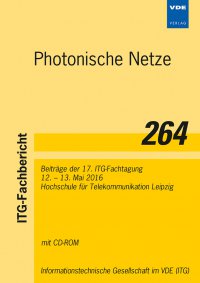How to design an optimized set of fibre-trees for filterless optical networks – The elegance of a multi-goal evolutionary Pareto optimization versus a deterministic approach
Konferenz: Photonische Netze - 17. ITG-Fachtagung
12.05.2016 - 13.05.2016 in Leipzig, Deutschland
Tagungsband: Photonische Netze
Seiten: 8Sprache: EnglischTyp: PDF
Persönliche VDE-Mitglieder erhalten auf diesen Artikel 10% Rabatt
Autoren:
Krannig, Simon; Gunkel, Matthias (Deutsche Telekom, Fixed Mobile Engineering Deutschland, Optical Packet Transport, Heinrich-Hertz-Str. 3-7, 64295 Darmstadt, Germany)
Moegel, Robert (Deutsche Telekom, Technische Planung und Rollout, Zielnetzplanung Verbindungsliniennetz, Dresdner Str. 78, 01445 Radebeul, Germany)
Kussel, Tobias; Michaelis, Niklas (Deutsche Telekom, Fixed Mobile Engineering Deutschland, IP-Carrier & Broadband Network, Deutsche-Telekom-Allee 7, 64295 Darmstadt & Technische Universität Darmstadt, Institut für Festkörperphysik, Hochschulstr. 6, 64289 Darmstadt, Germany)
Wissel, Felix (Deutsche Telekom, Fixed Mobile Engineering Deutschland, IP-Carrier & Broadband Network, Deutsche-Telekom-Allee 7, 64295 Darmstadt, Germany)
Drossel, Barbara (Technische Universität Darmstadt, Institut für Festkörperphysik, Hochschulstraße 6, 64289 Darmstadt, Germany)
Inhalt:
Filterless optical networks as proposed by DT’s TeraStream project rely on node architectures implemented by passive splitters and combiners abandoning commonly used active wavelength routing functionality. As a consequence, a set of pairwise non-interlinked fibre-optical trees is needed to establish a meshed connectivity for any given network topology. Every fibre-tree connects a specific subset of nodes, creating broadcast-like subnetworks. Unicast functionality is achieved by a proper wavelength assignment for every traffic relation. We propose a new algorithm, capable of creating optimized filterless network designs. It uses methods of evolutionary computation to alter the designs, taking specific properties like cost approximations and protection ratio into account. As the underlying search space of all possible fibre-tree combinations can only be examined heuristically, the evolutionary algorithm uses a selection method based on the maximization of the Lebesgue measure regarding the demanded network properties. Thereby, it creates a near Pareto-optimal set of solutions, which allows an a posteriori decision making. In almost all examined cases, the algorithm provides superior solutions compared to those created by a respective a priori method. Furthermore, the designs exemplarily achieved for DT’s 12 node core network provide insight into benefits and downsides of the filterless approach in general. Additionally, we present a deterministic algorithm to analytically construct a set of trees with minimal overall fibre utilization. This approach neglects all constraints stemming from physical impairments and focuses on the two main features, protection ratio and fibre usage.


